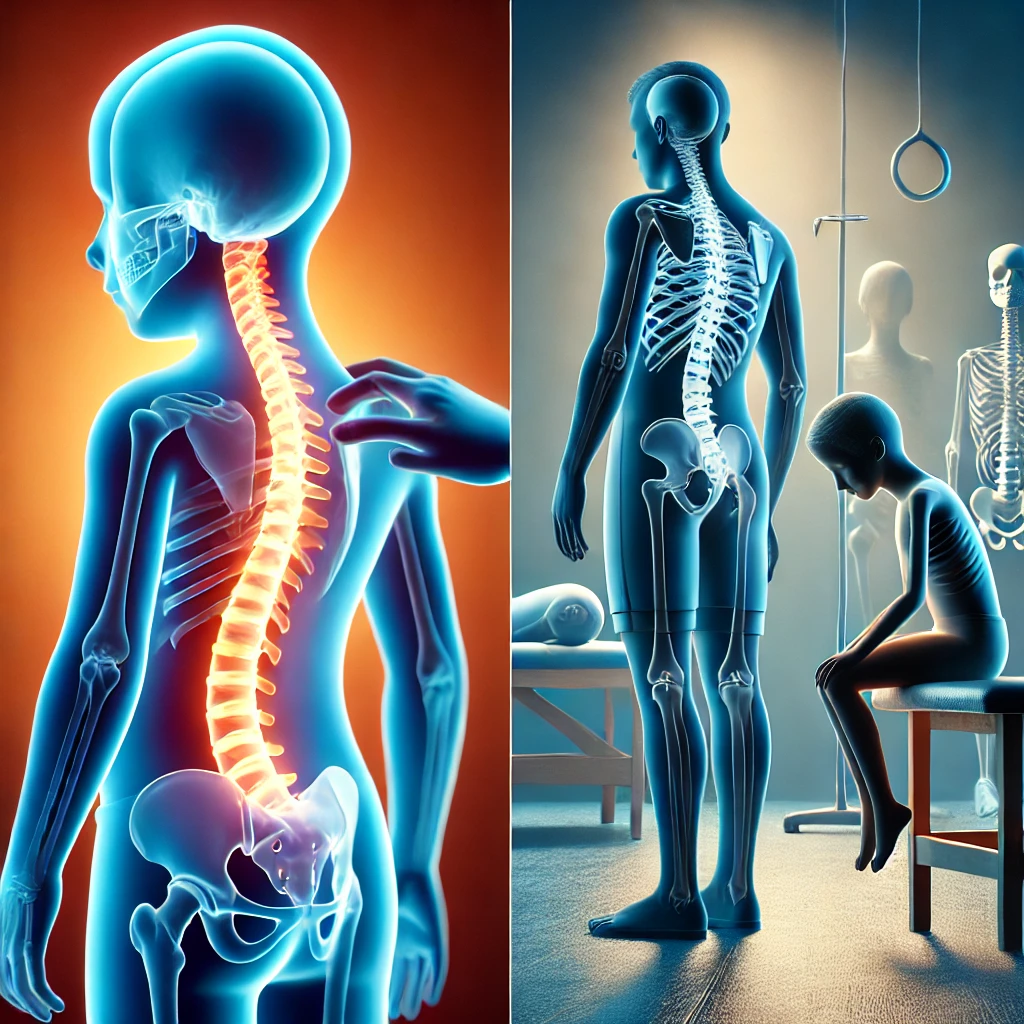Scoliosis is a medical condition that causes a sideways curvature of the spine. It often develops during a child’s growth spurt before puberty, though it can occur at any age. For parents, recognizing scoliosis in its early stages is crucial. Early detection can make treatment simpler, more effective, and less invasive.
This guide is designed to help you understand scoliosis, spot the early signs in your child, and explore the best treatment options. With insights from expert spine surgeons, you’ll feel confident about the steps you can take to support your child’s spinal health.
What is Scoliosis?
Understanding Scoliosis
Scoliosis occurs when the spine curves sideways in an “S” or “C” shape. While a healthy spine appears straight when viewed from the back, scoliosis causes uneven alignment.
Here’s what every parent should know about the condition:
- Types of Scoliosis
- Idiopathic (most common; cause unknown).
- Congenital (present at birth due to spinal malformations).
- Neuromuscular (caused by conditions like cerebral palsy or muscular dystrophy).
- Degenerative (develops in adulthood due to aging).
Why Does Scoliosis Matter?
Scoliosis can progress over time if untreated, leading to:
- Poor posture and alignment issues.
- Reduced lung and heart function in severe cases.
- Impacted confidence and self-esteem in children, especially teens.
By addressing scoliosis early, you can prevent it from interfering with your child’s health and daily life.
Early Signs of Scoliosis in Children

How to Spot the Signs of Scoliosis as a Parent
Scoliosis often develops subtly, but a parent’s eye can catch the early visible signs. Look for these symptoms in your child:
- Uneven shoulders.
- One shoulder blade that sticks out more than the other.
- Tilted head that doesn’t align with the hips.
- Uneven hips or noticeable lean to one side.
- Ribs that appear more prominent on one side.
The Adam’s Forward Bend Test is an easy way to check. Have your child bend forward at the waist. Watch for any unevenness or rib hump – a telltale sign.
Non-Visible Signs of Scoliosis to Watch Out For
Some signs may not be immediately obvious but are just as important, including:
- Persistent back pain, rare in children, but possibly linked to scoliosis.
- A change in how clothes fit, for example, shirts hanging unevenly.
- Mild fatigue or discomfort after prolonged sitting or standing.
Being observant can help you notice these subtle signs and take action before the curve worsens.
Diagnosis of Scoliosis
The Importance of a Professional Diagnosis
Even if you spot potential signs of scoliosis, achieving an accurate diagnosis requires an expert. Diagnostic tools include:
- X-rays to measure the degree of spinal curvature.
- Scoliometer for quick assessments of spinal tilt.
- MRI scans, used in rare cases for detailed imaging.
A spine expert can confirm scoliosis and provide tailored treatment plans based on the severity of the curve.
Who to Consult for Scoliosis
Your first stop may be a pediatrician, who will refer you to a specialist if necessary. Orthopedic spine surgeons are highly trained and experienced in managing scoliosis, offering both non-surgical and surgical solutions.
Early Treatment Options for Scoliosis
Non-Surgical Treatments for Minor Curves
Most mild cases of scoliosis don’t require surgery. Instead, these treatments may help manage it effectively:
- Bracing slows curve progression. Modern braces are lightweight and discreet, making them easier for kids to accept.
- Physical therapy strengthens back muscles and improves flexibility.
- Posture correction methods, like ergonomic school seating to support spinal alignment.
Observation and Monitoring
Not every scoliosis case needs immediate treatment. For smaller curves, doctors may recommend regular monitoring to track progression.
- Follow-ups occur every 6 months, especially during growth spurts.
- This approach ensures timely intervention if the curve worsens.
When Does Scoliosis Require Surgical Intervention?
Evaluating Severe Cases
Surgery is considered for larger curves, typically over 45–50 degrees, especially if scoliosis affects breathing or mobility. Delaying may lead to complications or severe deformities.
Advances in Scoliosis Surgery
Modern technology offers minimally invasive options, making scoliosis surgery safer and recovery quicker. Key benefits include:
- Reduced pain and faster healing.
- High success rates with improved spinal alignment.
- Suitable even for younger patients with severe curves.
Coping with a Scoliosis Diagnosis
Helping Children Emotionally
Receiving a scoliosis diagnosis can be overwhelming for both parents and children. Here’s how to offer support:
- Reassure your child that scoliosis is manageable and common – many kids face the same issue.
- Encourage their confidence by celebrating their strengths and talents.
Building a Support System for Your Family
Connect with other families through scoliosis support groups. Sharing experiences and learning from others can help both you and your child.
Preventing Scoliosis from Progressing
Lifestyle Tips for Parents and Children
Encourage activities that promote spine health, such as swimming or yoga. Teach your child the importance of good posture, especially when sitting for long hours.
Regular Health Check-ups
Routine doctor visits are vital. Early X-rays and physical exams during rapid growth phases can catch scoliosis before it worsens.
FAQ Section
Is scoliosis hereditary?
Yes, scoliosis can run in families, though its exact cause is genetic and environmental.
Can scoliosis be cured completely?
While it cannot be completely reversed, early treatment ensures better spinal health and prevents complications.
Will my child’s scoliosis worsen with age?
Without treatment, some scoliosis cases progress over time, particularly during growth spurts.
Are there any sports children with scoliosis should avoid?
High-impact sports should be limited in severe cases, but most activities are safe with proper guidance.
Call to Action
Take the Next Step for Your Child’s Spine Health
If you’ve noticed any signs of scoliosis in your child, don’t wait. Schedule an evaluation with a scoliosis expert today. Early detection leads to effective care and a healthier future.
Contact us now for a consultation and ensure your child’s spinal alignment is on track. Our team of experienced specialists is here to guide you every step of the way.

